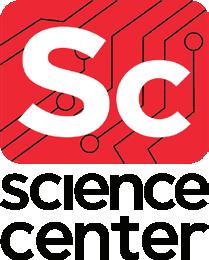
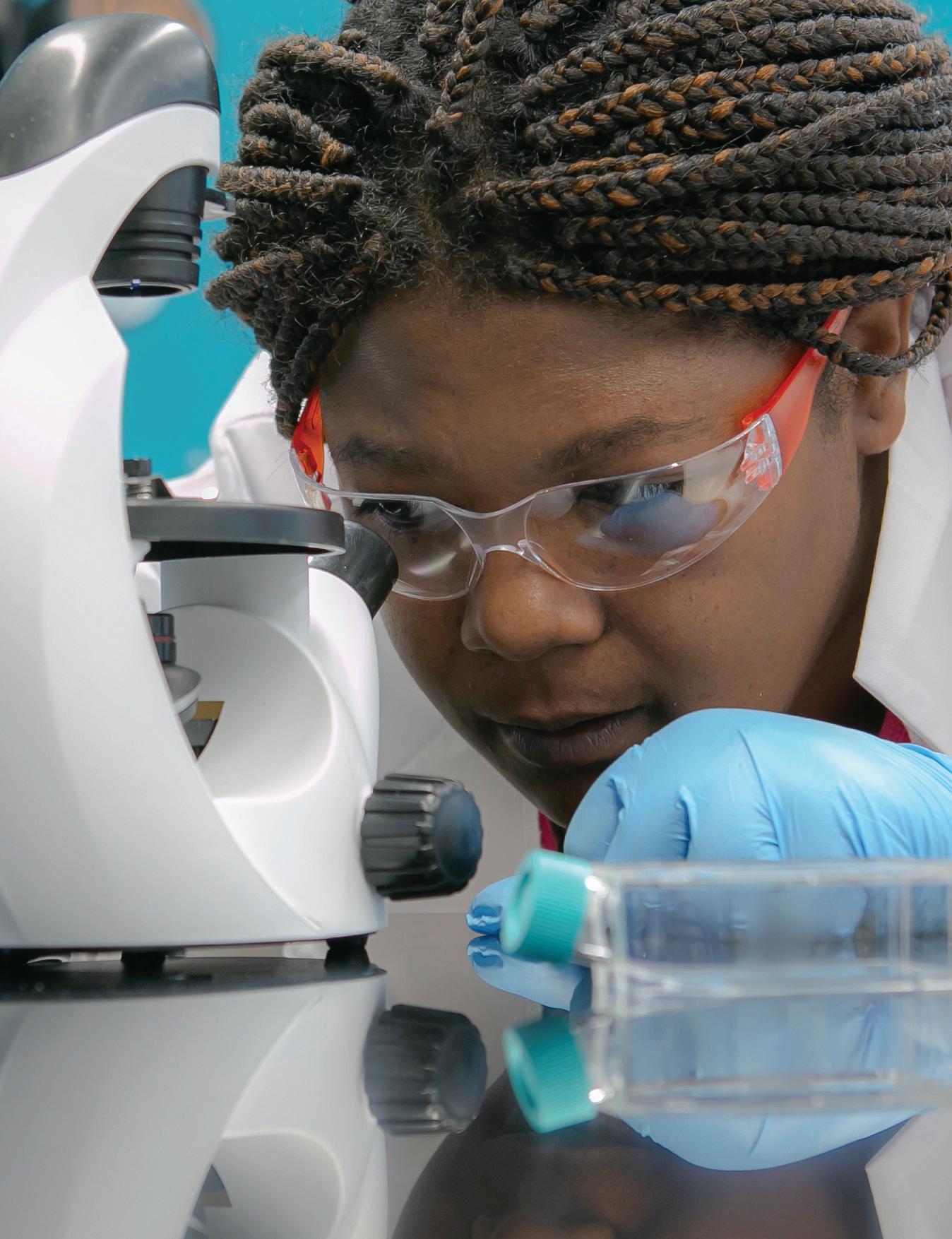
December 2023
Filling Startup Ecosystem Gaps Since 1963 University City Science Center


Founded in 1963, the University City Science Center is a dynamic hub for innovation, entrepreneurship and technology development in the Greater Philadelphia region. Our 30 nonprofit shareholders include many of the distinguished colleges, universities, hospitals, and research institutions located throughout Pennsylvania, New Jersey, and Delaware. As a leader, connector, and convener, the Science Center fosters collaboration among leading institutions, driving technology transfer and startup creation to transform research concepts into new businesses.
All images were provided by the Science Center for use in this report.
Connector
Convener Leader
3 CONTENTS 4 Supporting the Startup Ecosystem Outline of this Report Introduction to the Science Center Section 1 20 Impacts of uCity Square Section 3 uCity Square Impacts on the Local Community 26 The Science Center in the Regional Innovation Ecosystem Section 4 The Economic Importance of Philadelphia’s Life Sciences Industry The Science Center as a Catalyst for Inclusive Economic Growth Regional Impact of Science Center Supported Companies Section 2 Regional Employment at Science Center Supported Companies Economic Impact from Employment at Science Center Supported Companies Case Studies 8 The mission of the University City Science Center is to power progress that advances life science and healthcare innovation, uplifts communities, and improves lives.
Introduction to the Science Center

The University City Science Center (“Science Center”) is a Philadelphia-based non-profit organization with the mission to power progress that advances life science and healthcare innovation, uplifts communities, and improves lives. This report explores and documents a range of economic impacts at the local and regional level that result from the Science Center’s programmatic activity to the innovation and startup ecosystem.
The Science Center was established in 1963 by a group of leading academic and research institutions to serve as a supportive extramural space where bright scientific ideas could evolve into scientific solutions to benefit society. Considered the first and largest urban research park in the nation, the Science Center has evolved its real estate approach and programming over time to adapt to the changing needs of the innovation community. However, throughout its tenure, its core objective has remained constant: filling gaps in the startup ecosystem to serve as a catalyst for economic growth in the Philadelphia region’s life sciences sector.
University City Science Center 4
INFRASTRUCTURE LABOR CAPITAL ENTREPRENEURSHIP
Startups, regardless of the industry they operate in, face a high risk of failure. Life sciences commercialization in particular can possess costs that are prohibitively high, involving cutting-edge research and development, extensive testing and validation, regulatory approvals, and market adoption challenges. With the ever-changing and costprohibitive nature of the life sciences sector, the risks of failure are amplified. While there are numerous reasons why startups fail, key problems include misalignment or gaps in the affordability, availability, or quality of the inputs required for economic production. Those inputs include entrepreneurial competence, capital, labor, and infrastructure.
Supporting the Startup Ecosystem
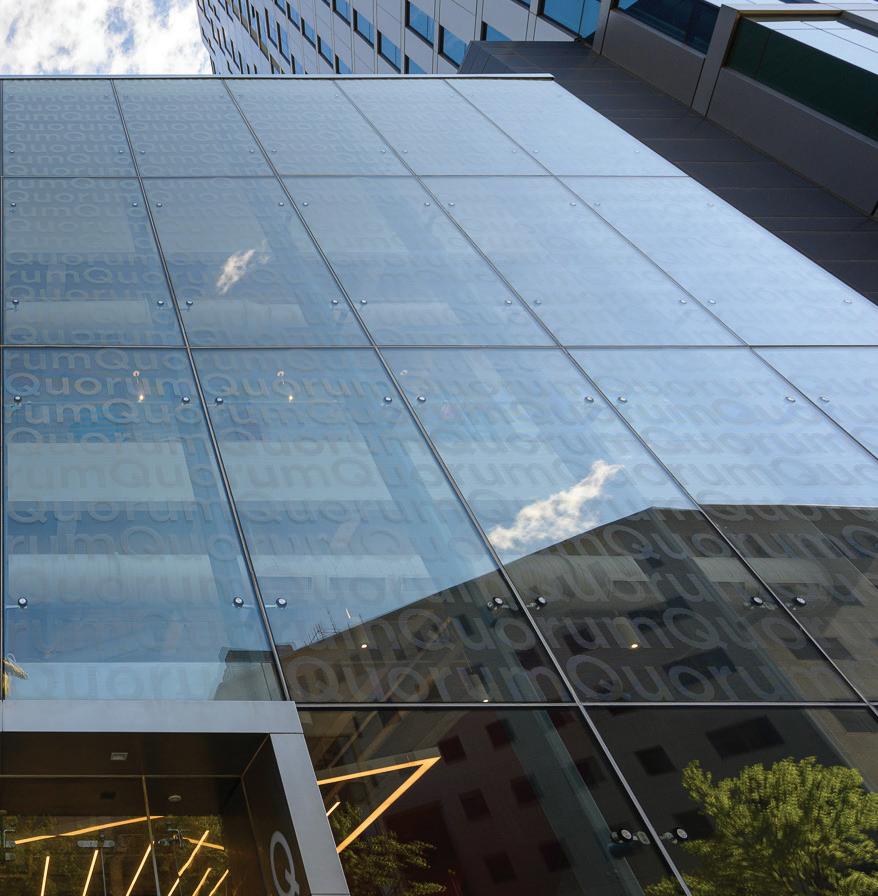
Entrepreneurship: The entrepreneurial capabilities of the founders and management team play a significant role in the success or failure of a startup. Effective leadership, strategic decision-making, and adaptability are essential for navigating the uncertainties and challenges inherent in starting a new venture. Inadequate entrepreneurial skills or a lack of experience can lead to poor decisionmaking, which may hamper the startup’s growth potential.
Capital: Startups need financial resources to develop their products or services, invest in marketing and sales, and sustain operations until they become profitable. Insufficient capital or poor financial management can lead to cash flow problems and ultimately the failure of the startup.
Labor: Hiring and retaining talented employees is crucial for the success of a startup. However, startups often struggle to attract skilled individuals due to limited resources, competition from more established companies, or lack of availability of specific skill sets within their labor market. Inadequate human capital can hinder the growth, innovation, and viability of a startup organization.
Infrastructure: In the context of startups, finding suitable office or laboratory space can be challenging and costly, especially for life sciences companies that may require unique facilities and technical needs. Limited access to appropriate facilities can impede a startup’s ability to conduct research, development, and production.
Introduction Filling Startup Ecosystem Gaps Since 1963 5
Introduction
Each of these obstacles alone has the potential to significantly impede the sustainability of an emerging life sciences startup, with an estimated 90 percent failure rate.1 Recognizing the importance of addressing these obstacles nearly six decades ago, a collective of academic and research institutions in the current day University City neighborhood of Philadelphia came together with a common goal: to provide a platform for researchers and entrepreneurs to convene, collaborate, and advance science and technology. This effort aimed to create an environment where innovative ideas could flourish, research could be translated into practical applications, and startups could receive the support they needed to thrive. In 1963, the University City Science Center was born.
Since its establishment in 1963, the University City Science Center has supported 710 companies, playing a pivotal role in fostering inclusive economic growth in the Greater Philadelphia region through its support for life sciences startups and innovation activity. The Science Center fills startup ecosystem gaps to drive inclusive growth through entrepreneurial education, startup support and capital, STEM education and workforce training, and infrastructure via physical facilities. The goals of this approach are to enhance the ecosystem by transitioning STEM grads to life sciences founders, preparing startups to become investment-ready, accelerating startups from research to commercial success, filling the earlystage capital gap in Philadelphia, and ensuring both access to talent for companies and access to career opportunities for Philadelphians.
Key Science Center deliverables supporting startups and the innovation ecosystem include:
Entrepreneurship: Best-in-class innovation programming provides the resources and support entrepreneurs need to transition their idea, or startup, to the next level.
Capital: The mobilization of capital and related technical assistance is offered to help innovators accelerate promising technologies into successful commercial enterprises.
Labor: The region’s life sciences workforce is cultivated through education, and training programs offered to support the needs of emerging sectors while connecting local populations to employment opportunities.
Infrastructure: uCity Square offers flexible office and laboratory space for early-stage companies as well as custom-fit opportunities for more established businesses.
This continuum of support for businesses at all stages creates a vibrant ecosystem representing the full lifecycle of innovation. By providing a range of services to entrepreneurs, the Science Center drives innovation within the region, creating significant economic activity throughout the Greater Philadelphia region. Through these various avenues, the Science Center aims to catalyze Philadelphia’s entrepreneurs and accelerate technology innovation that addresses society’s biggest challenges.
1 Axios,
https://www.axios.com/2023/03/13/silicon-valley-bank-failure-spooks-
University City Science Center 6
“Silicon Valley Bank Failure Spooks Digital Health, Biotech Industries.” Mar 13, 2023
health
Outline of this Report
The Science Center plays a pivotal role in bolstering both the local and state economies through its support of startups and its contributions to the innovation ecosystem. This study aims to comprehensively assess and, where feasible, quantify the diverse impacts of the Science Center and its activities on the regional economy.
The examination of these impacts is organized into three distinct chapters, each delving into a different layer. At the local level, the uCity Square campus fosters development and sustains employment, thus enhancing the vibrancy of the surrounding community. On a broader scale, companies nurtured by the Science Center expand their influence as they mature, evolving into key drivers of regional employment and economic growth over their lifecycle. Furthermore, the regional innovation ecosystem nurtured by the Science Center emerges as a vital catalyst for Pennsylvania’s economic expansion, presenting a pivotal opportunity for fostering inclusive growth in the Philadelphia region.
REPORT SEQUENCE AND STRUCTURE
Section 2 Economic Impact of Science Center Supported Companies: The Science Center’s vision is to catalyze inclusive entrepreneurship and accelerate life sciences and technology innovation in Greater Philadelphia, thus fostering the growth of new companies and job creation. This section details how the Science Center empowers startups and accelerates their commercialization. This company formation and growth generates noteworthy economic impacts for the region.
Section 3 uCity Square: uCity Square is comprised of multiple buildings located in the University City neighborhood of Philadelphia. This section details how the Science Center’s physical presence creates local economic activity, supporting jobs within and outside the life sciences sector, and how the organization works to curate a thriving and inclusive innovation ecosystem.
Section 4 The Science Center in the Regional Innovation Ecosystem: Innovation centers and districts function as key drivers of growth and competitive differentiators for their regions. This section details how the Science Center aligns with broader innovation plans and plays an important convening role in the region.

Filling Startup Ecosystem Gaps Since 1963 7
Introduction
Regional Impact of Science Center Supported Companies
Many of the startups that have received support from the Science Center have not only survived but thrived. As they expand and scale their operations, these companies create economic activity and job opportunities within the Philadelphia region that span various sectors and skills. The operations and purchasing activity of these companies and of their employees supports local businesses and stimulates consumer spending, further fueling economic growth and generating additional employment opportunities.
Of the more than 710 companies that have been supported by the Science Center, over 200 companies are thriving in the Greater Philadelphia region, contributing to the dynamic success of the region today. This section presents analyses that aim to quantify the current economic and fiscal impact of these more than 200 companies which are flourishing in the Greater Philadelphia region.
710 COMPANIES SUPPORTED BY THE SCIENCE CENTER more than
since 1963
of those 710 companies, more than
200 ARE THRIVING TODAY IN THE GREATER PHILADELPHIA REGION

University City Science Center 8
Regional Employment at Science Center
Supported Companies
Throughout the past sixty years, the Science Center has supported startup firms within the Philadelphia region in a number of ways. Through resource accessibility, mentorship, and funding, these firms have been empowered to refine their products and services, broaden their customer reach, and foster new employment prospects.
The Science Center’s support services include physical space and a broader ecosystem of support described throughout this report. These incubation services foster a community comprised of all stages of innovation from entrepreneurs with nascent ideas in need of business development support and collaboration to an enterprise business looking to scale.
In addition to infrastructure and access to capital, Science Center programming and connections help entrepreneurs to navigate the complex journey of turning ideas into successful ventures. Through workshops, seminars, startup support programs, and networking events, Science Center programs offer fertile ground for collaboration,
enabling entrepreneurs to exchange insights, forge partnerships, and amplify their market presence. Programming also provides opportunities for cross-disciplinary engagement, thereby fostering a culture of collaboration between entrepreneurs, researchers, and residents. Local startups gain access to programs which provide instruction related to entrepreneurship (professional development, raising capital, understanding target market); and life sciences (commercialization support, sellable tax credits); and equity and inclusion (access to capital for diverse founders).
Over time, many incubated firms have grown within the region, while others have been acquired by larger companies or have had successful exits through mergers. These acquisitions and exits not only benefit the entrepreneurs and investors but also bring new talent and investment into the region. The success also extends beyond the region, both through the technologies and applications that companies produce and through the location of some graduates in other parts of the county and the world.
Regional Impact of Science Center Supported Companies Filling Startup Ecosystem Gaps Since 1963 9
Current Economic Impact of Science Center Supported Companies
The Science Center provides assistance to startups by providing access to:
• Best-in-class startup support programming;
• Early-stage capital;
• Experienced business consultants, management-level executives, and mentors;
• Physical space; and
• Information and research resources via relationships with local universities.
Companies that successfully exit this initial phase can grow into durable employers and significant contributors to the regional economy. Over the life of the Science Center, the ongoing regional impact of companies that it has previously supported represents a major component of its economic impact.
This analysis estimates the current annual employment and economic impact for companies supported by the Science Center that are still in operation (or have been acquired) within the Greater Philadelphia region. This includes companies which have been provided office and laboratory space, access to financing and investors, and logistical resources.2 Notably, those companies supported more recently are at an earlier stage of their life cycle, and their current employment footprint and economic impact may not be reflective of their future growth trajectory and ultimate circumstances.
Based on data supplied by the Science Center, 218 companies were identified that have been supported by the Science Center and are currently in operation today within the Greater Philadelphia region. The current employment level of these companies was researched through a combination of online sources.
Companies supported by the Science Center which are currently in operation within the Greater Philadelphia region have an estimated current footprint of 13,091 employees within the region. 111 of these companies, representing 6,170 employees, are located within the City of Philadelphia while the remaining 107 companies, representing 6,921 employees, are located within Bucks, Montgomery, Chester, and Delaware counties.
NUMBER OF EMPLOYEES WORKING AT COMPANIES SUPPORTED BY THE SCIENCE CENTER
13,091 Employees @ 218 Companies
LOCATED IN THE GREATER PHILADELPHIA REGION
6,921 Employees @ 107 Companies
LOCATED IN BUCKS, CHESTER, DELAWARE, & MONTGOMERY COUNTIES
6,170 Employees @ 111 Companies
LOCATED IN THE CITY OF PHILADELPHIA
(See the table on page 11.)
2 Many additional companies have interacted with the Science Center and the broader ecosystem that it cultivates through participation in events, programs, mentorship, and training. This analysis conservatively considers those companies that have not been provided office and laboratory space, access to financing and investors and logistical resources not to have been “incubated” by the Science Center and excludes these companies from the economic analysis. Incubated companies currently located outside of the Philadelphia region are also excluded, as the economic impact estimates are focused on the Philadelphia region.
University City Science Center 10

LEADING IN WORKFORCE DEVELOPMENT AND STEM EDUCATION
The Science Center supports the life sciences industry with a workforce pipeline and aids in efforts to ensure that the benefits of new economic activity reach the local community and region. The Science Center offers comprehensive educational programs to Philadelphia’s youth by connecting them to STEM professionals in a variety of fields to showcase the vastness and range of STEM careers, and by supplementing classroom learning with hands-on, projectbased curricula in the designated learning lab. The Science Center connects adults without a traditional four-year degree to STEM training and careers, furthering the pipeline of talent for the life sciences ecosystem. A five-week program for Philadelphia adults with an interest in STEM is offered free of cost. To achieve inclusive growth, it is imperative that all Philadelphians have the opportunity to participate in and benefit from the region’s thriving innovation ecosystem.
Regional Impact of Science Center Supported Companies Filling Startup Ecosystem Gaps Since 1963 11
Sector Employment at Philadelphia Companies Employment at Rest of Region Companies Total Regional Employment Scientific Research and Development Services 4,807 3,445 8,252 Other Financial Investment Activities 108 3,291 3,399 Management Consulting Services 528 – 528 Electromedical and Electrotherapeutic Apparatus Manufacturing 209 178 387 Other Educational Services 211 2 213 Pharmaceutical Preparation Manufacturing 130 – 130 Nondepository Credit Intermediation and Related Activities 61 – 61 Marketing Research and Other Services 41 – 41 Radio and Television Broadcasting 39 – 39 Legal Services 28 – 28 Individual and Family Services 8 – 8 Custom Computer Programming Services – 5 5 Total 6,170 6,921 13,091
Estimated Current Employment for Companies Supported by the Science Center
Source: Science Center (2023), Econsult Solutions, Inc. (2023)
Economic Impact from Employment at Science Center Supported Companies
The businesses supported by the Science Center create significant economic activity within Philadelphia, as well as within the regional and state economies through direct, indirect, and induced impacts. These impacts occur because goods and services are produced locally, salaries are spent locally; and, in both cases, local businesses are supported.
Based on the employment footprint, location and industry sectors of graduate companies, economic modeling is performed to estimate their total direct and indirect economic footprint within the city and region. This study estimates the current regional economic impact of the employment and activity at companies incubated at the Science Center which are operating today.
The current annual regional economic impact of Science Center-supported companies within the Greater Philadelphia region is estimated at $7.6 billion, supporting more than 29,100 full-time equivalent (FTE) jobs with $2.6 billion in employee compensation. Within the city of Philadelphia, this activity is estimated at an annual impact of $3.3 billion, supporting nearly 12,000 FTE jobs with $1.09 billion in employee compensation. This activity accounts for one out of every 142 jobs in Greater Philadelphia. It also generates an estimated $171.5 million in combined annual tax revenue for the Commonwealth of Pennsylvania and the City of Philadelphia.
$7.6 Billion
CURRENT ANNUAL REGIONAL ECONOMIC IMPACT OF SCIENCE CENTER SUPPORTED COMPANIES WITHIN THE GREATER PHILADELPHIA REGION
University City Science Center 12
Direct, Indirect, Induced, Full-Time Employment (FTE), Employee Compensation
1 OUT OF 142 JOBS RESULT FROM THE SCIENCE CENTER’S IMPACT IN THE GREATER PHILADELPHIA REGION
Source: Lightcast (2023), Econsult Solutions (2023)
Source: IMPLAN (2021), Econsult Solutions (2023)
Regional Impact of Science Center Supported Companies
Filling Startup Ecosystem Gaps Since 1963 13
PHILADELPHIA REGION PHILADELPHIA $1.48B INDIRECT & INDUCED $3.84B INDIRECT & INDUCED $1.84B DIRECT $3.76B DIRECT $7.60B TOTAL REGION $3.32B TOTAL PHILADELPHIA
FTE EMPLOYMENT SUPPORTED $1.09B EMPLOYEE COMPENSATION
FTE EMPLOYMENT SUPPORTED $2.64B EMPLOYEE COMPENSATION
Annual Economic Impact from Operations of Companies Supported by the Science Center Within the Greater Philadelphia Region
GREATER
11,920
29,120
This direct and spillover economic activity also generates a considerable level of tax revenue for state and local jurisdictions. Based on fiscal analysis of ratios between economic activity and tax collections, it is estimated that the current regional economic activity attributable to companies incubated at the Science Center generates approximately $52 million in taxes to the City of Philadelphia per year, as well as approximately $120 million to the Commonwealth of Pennsylvania (see table on the top right). Since the City and Commonwealth comprise separate tax bases, the estimated total fiscal impact is summative. The annual tax revenue impact of the Science Center incubated companies to the City of Philadelphia and the Commonwealth of Pennsylvania is more than $171 million.
Of this $171.5 million in annual tax revenue, $100.2 million is generated by the direct employment and activity generated by the Science Center supported companies, while $71.2 million is generated from the indirect (supply chain) and induced (laborincome recirculation) impacts of these companies (see table on the bottom right).

University City Science Center 14
City and State
Operations of Companies Incubated by the Science Center Tax Type Philadelphia Pennsylvania Total Income Tax ($M) $31.6 $45.9 $77.5 Sales Tax ($M) $7.2 $54.4 $61.7 Business Taxes ($M) $13.1 $19.2 $32.3 Total Tax Revenue ($M) $51.9 $119.5 $171.5
Annual
Tax Revenue Impacts from
Source: IMPLAN (2019), Econsult Solutions (2023)
Impact Type Philadelphia Pennsylvania Total Tax Revenue from Direct Impact ($M) $42.1 $58.2 $100.2 Tax Revenue from Indirect/ Induced Impact ($M) $9.8 $61.4 $71.2 Total Tax Revenue ($M) $51.9 $119.6 $171.5
Direct and Indirect/Induced Tax Revenue Impacts from Operations of Companies Incubated by the Science Center
Source: IMPLAN (2019), Econsult Solutions (2023)

Regional Impact of Science Center Supported Companies Filling Startup Ecosystem Gaps Since 1963 15
Case Studies
Companies profiled on the following pages, Integral Molecular, Spirovant and UE LifeSciences, have benefited from the incubation and entrepreneurial support services provided by the Science Center. They now serve as significant employers and regional economic drivers.
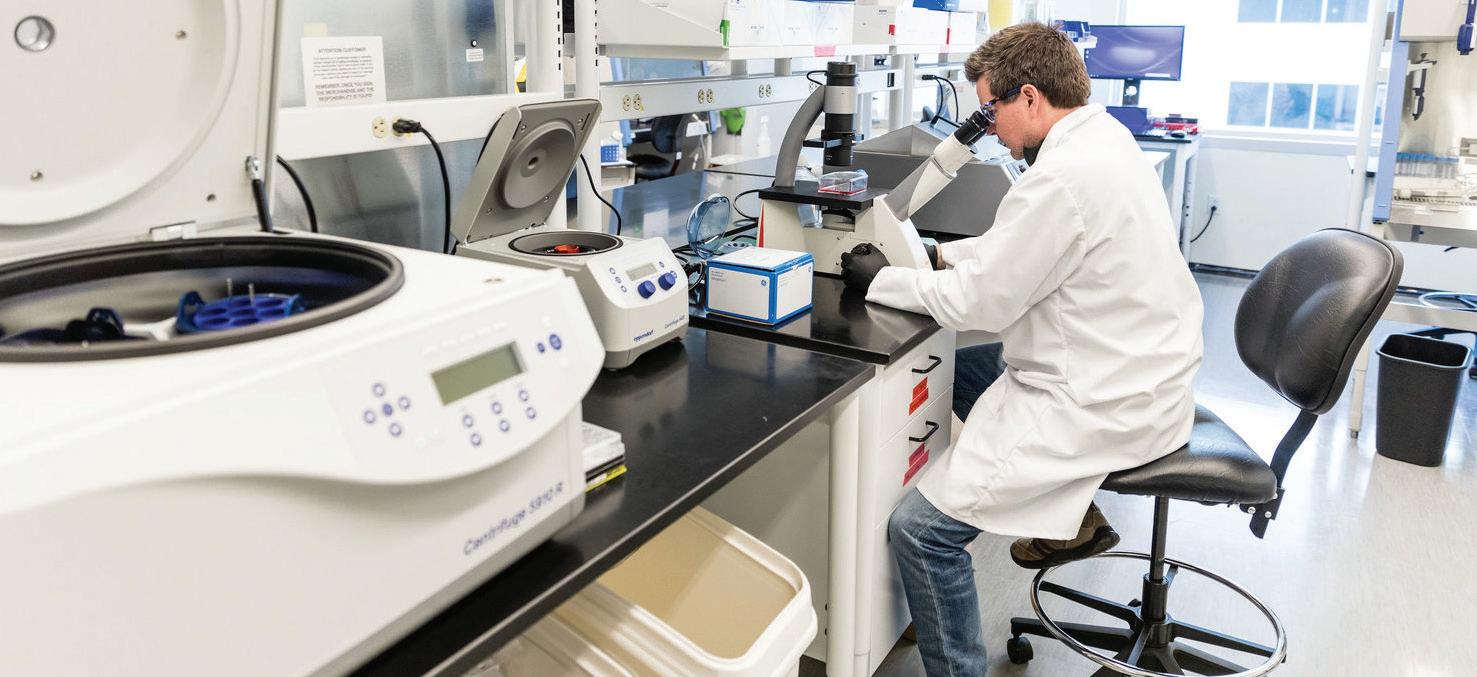
University City Science Center 16
Integral Molecular
Founded in 2001
COLLABORATING TO CHAMPION EQUITABLE HEALTHCARE PRACTICES
Integral Molecular, a renowned leader in antibody discovery and virology, has emerged as a frontrunner in creating groundbreaking technologies and therapeutic antibodies for underexploited membrane protein targets.
Founded in 2001 by Benjamin Doranz, PhD, Sharon Willis, PhD, and Joseph Rucker, PhD, the company has grown significantly, currently having a workforce of about 100 employees. Integral Molecular actively collaborates with esteemed organizations such as Philadelphia Fight to champion equitable healthcare practices.
A significant part of Integral Molecular’s success can be attributed to the support it received from the Science Center, particularly during its fledgling years with limited resources. The company greatly benefited from shared resources and state-of-the-art equipment accessible through the Science Center. Furthermore, the incubator program provided valuable opportunities for the growing company to build connections with fellow entrepreneurs and tap into the extensive network of resources within the ecosystem. It was within this nurturing environment that Integral Molecular thrived, prompting its graduation from the incubator into a custom-fit office and laboratory,
continuously expanding its footprint across uCity Square, and finally establishing its headquarters at One uCity Square in Philadelphia.
A core tenet of Integral Molecular’s ethos is its steadfast commitment to giving back to the community. To this end, the company actively collaborates with the Science Center on skills-based training programs. By participating in these programs, local residents develop a diverse array of valuable skills, many of which align seamlessly with Integral Molecular’s hiring needs. From apprenticeships to internships, Integral Molecular consistently engages with the Science Center’s STEM education and training initiatives to empower the local community and create familysustaining employment opportunities.
By offering crucial resources, fostering a collaborative ecosystem, and championing skills-based STEM training programs, the Science Center has been instrumental in catapulting Integral Molecular to its current position as a pioneering force in antibody discovery and virology. “Twenty years ago, Integral Molecular embarked on a journey of scientific innovation. Proudly rooted in Philadelphia, we’re thrilled for this next chapter to unfold,” said
Sharon Willis, PhD, Co-Founder of Integral Molecular. “uCity Square is more than just lab and office space; it also represents a dynamic cluster of talent, innovation, collaboration, and opportunity that helps our recruiting, research, partnerships, and productivity.” (Release, 2023)
The company’s remarkable success story stands as a testament to the transformative power of strategic partnerships and community-driven initiatives, ultimately shaping a future where scientific advancements are harnessed to uplift society.
A core tenet of Integral Molecular’s ethos is its steadfast commitment to giving back to the community.
To this end, the company actively collaborates with the Science Center on skills-based training programs.
Case Studies Filling Startup Ecosystem Gaps Since 1963 17
Spirovant
Founded in 2016
LEVERAGING THE SCIENCE CENTER ECOSYSTEM FOR INNOVATION AND GROWTH
Spirovant is a gene therapy company developing treatments and cures for respiratory diseases including cystic fibrosis. It was founded in 2016 and is headquartered at uCity Square. It was initially founded by Joan Lau, PhD, MBA and Eric Yuen, MD under the name Talee Bio. Following a series of acquisitions, the company rebranded as Spirovant in 2019. Currently, Spirovant boasts a team of 30 employees.
Early funding provided by the Science Center played a pivotal role in fostering the growth of Spirovant. Spirovant utilized incubator lab space from the Science Center to
get started in Philadelphia. The affordable lab space and business support from the Science Center helped the young startup establish operations. Just a few years later, the Cystic Fibrosis Foundation committed up to $4.5 million to the company to expedite the preclinical development of two mutation-agnostic gene therapy product candidates.
The company has benefited from the deep gene therapy talent pool in Philadelphia. As an emerging hub for gene therapy research, the city offered experienced researchers and partnerships with institutions like Children’s Hospital of Philadelphia.
Overall, Spirovant’s founding and growth in Philadelphia demonstrates how biotech startups can leverage the resources of the Science Center and broader startup ecosystem to build a successful gene therapy company. The startup infrastructure provided by the Science Center was critical, particularly in the company’s early stages.
The Cystic Fibrosis Foundation committed up to $4.5 million to Spirovant to expedite the preclinical development of two mutationagnostic gene therapy product candidates.
University City Science Center 18
UE LifeSciences
Founded in 2009
NURTURING THE GROWTH OF PIONEERING RESEARCH THAT IMPROVES PATIENT CARE
UE LifeSciences stands as a remarkable exemplar of success in the life sciences sector, and its growth trajectory has been significantly bolstered by the steadfast support and resources provided by the Science Center. Founded with a vision to revolutionize cancer detection and diagnostics, UE LifeSciences has emerged as a pioneering force in the industry, with its innovative non-invasive technologies making a profound impact on patient care.
The Science Center played a pivotal role in nurturing UE LifeSciences’ growth from its early stages. Through strategic partnerships, financial support, and access to state-of-the-art facilities,
the Science Center provided an environment conducive to research, development, and commercialization. UE LifeSciences was able to leverage the Science Center’s extensive network to connect with experts, mentors, and potential collaborators, thus accelerating its progress in refining and scaling its breakthrough technologies.
The Science Center’s support went beyond tangible resources; it fostered an ecosystem of collaboration and innovation that proved essential for UE LifeSciences’ success. The Science Center’s reputation as a convener of industry leaders, researchers, and investors facilitated opportunities for UE LifeSciences to showcase its
advancements, attract investment, and forge strategic partnerships. This environment not only propelled UE LifeSciences’ growth but also validated its vision and technologies within the broader life sciences community.
UE LifeSciences’ achievements stand as a testament to the Science Center’s effectiveness in nurturing startups and propelling them toward impactful contributions in the life sciences arena. The partnership between UE LifeSciences and the Science Center exemplifies how collaborative ecosystems can provide the crucial support needed for innovative companies to thrive and make lasting contributions to their field.
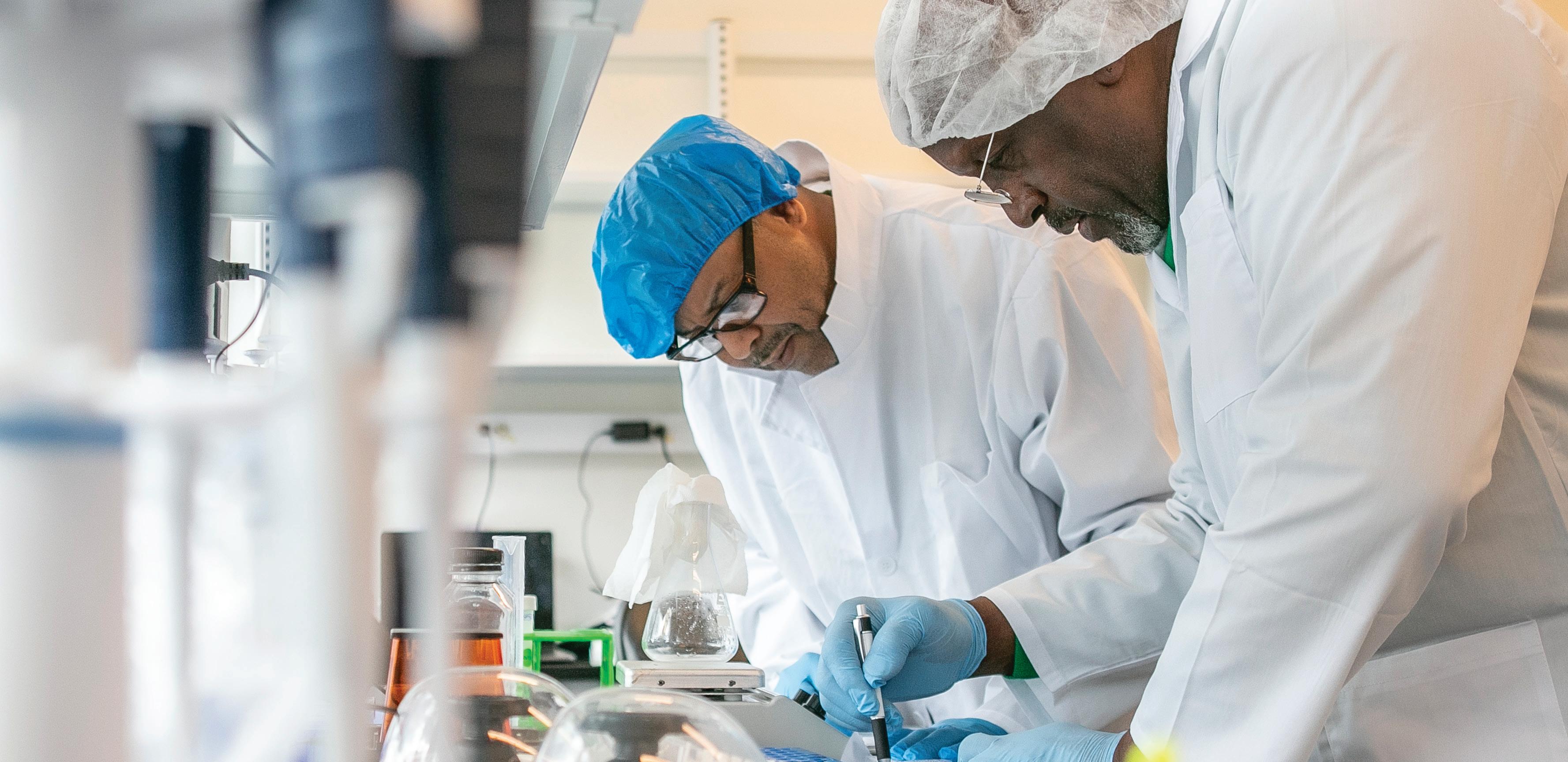
Filling Startup Ecosystem Gaps Since 1963 19
Impacts of uCity Square
In 2015, the Science Center entered into a partnership with Wexford Science & Technology, LLC and later Ventas, Inc. to collaborate on the development of uCity Square (formerly known as the Science Center campus). This partnership has enabled investment in mixed use facilities that have significantly expanded the scale and range of activity across a 27-acre campus that continues to grow. These collaborative spaces, laboratories, and shared facilities that make up uCity Square foster an environment of cross-pollination and knowledge exchange. By hosting events, conferences, and networking opportunities, the Science Center facilitates connections among entrepreneurs, investors, researchers, the creative-class, and industry leaders, fostering a vibrant ecosystem that drives innovation and economic growth.
This section highlights the significant economic impacts stemming from the development of uCity Square, and the ongoing activity of its tenants. It also discusses the steps that the Science Center has taken to curate an inclusive community within this campus and the broader life sciences ecosystem, and the benefits of this resilient and growing activity to the local economy.
uCity Square is more than just lab and office space; it also represents a dynamic cluster of talent, innovation, collaboration, and opportunity that helps our recruiting, research, partnerships, and productivity.
Sharon Willis, PhD, Co-Founder, Integral Molecular
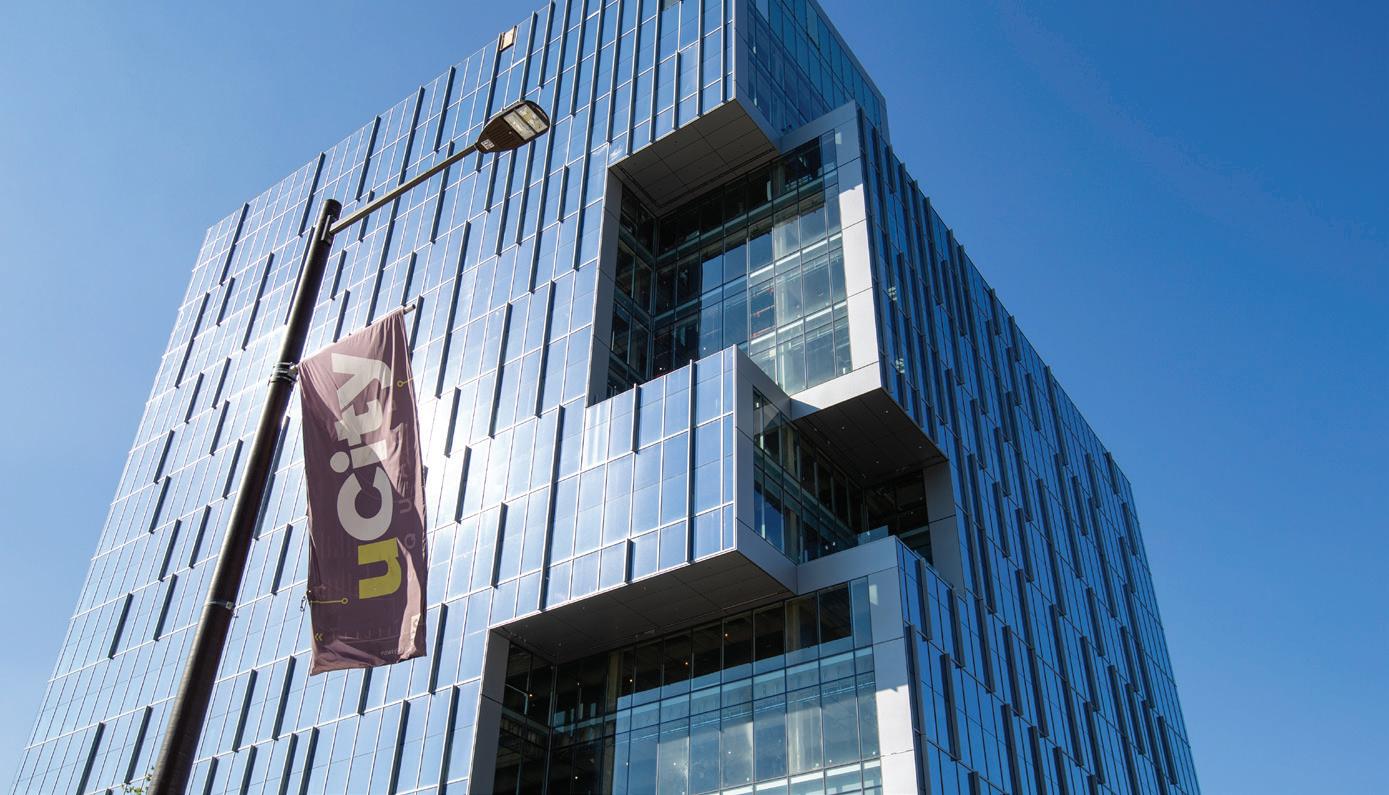
University City Science Center 20
In 1963, the Science Center campus was established as the first urban research park in the United States. By 2014, the Science Center, then the largest urban research park in the nation, held fifteen properties totaling 2.4 million square feet (developed or managed) across seventeen acres within the Philadelphia region, supporting or incubating over 600 businesses during this time.
In 2015, the Science Center embarked on development of a new hub for innovation in University City through a strategic partnership with Wexford Science & Technology, LLC, and later with Ventas, Inc., both leading developers and investors in university-based research and innovation activity across the country. This partnership yielded the capital and expertise to greatly expand the scale and quality of innovation and lab space and enhance the community and ecosystem that the Science Center seeks to cultivate. With this partnership and the development of major facilities, the 27-acre campus footprint has been branded as uCity Square.
uCity Square
the campus features more than 200 life sciences companies across a range of sizes and stages of the innovation life cycle. The Science Center is integral to the larger ecosystem of startups, non-profits, and research institutions comprising uCity Square. Its footprint on the campus is significant, including land and full or partial ownership in six buildings.
The real estate operations of uCity Square alone are a major catalyst for economic growth for the community, the Philadelphia region, and the Commonwealth of Pennsylvania. The Science Center and its partners Wexford and Ventas plan to continue to develop the campus to include an additional 4 million square feet of mixed-use space, growing the innovation community to a total of 8 million square feet and spanning 11 city blocks.3
The Science Center also operates a variety of spaces within uCity Square that are open to the public and foster community engagement. These include the Quorum Lounge, a free drop-in space for work and casual meetings; and Venture Café Philadelphia, a weekly gathering featuring high impact programming that is tailored to entrepreneurs and innovators.
Today, uCity Square has developed into a mixeduse community that is the heart of the Greater Philadelphia life sciences innovation ecosystem. With laboratory, office, retail, and residential space, 3 https://ucitysquare.com/wexford-science-technology-and-partners-cut-ribbon-on-one-ucity-square/
Impacts of uCity Square Filling Startup Ecosystem Gaps Since 1963 21
ONE UCITY SQUARE
In September 2023, the Science Center and its partners celebrated the ribbon cutting for One uCity Square, the newest addition to the uCity Square Campus. This 400,000 square foot development located at 37th and Cuthbert Streets is a 13-story lab and office building with ground floor retail and convening space.
Buildings like One uCity Square are substantial economic drivers, both during construction and post-development. A 2019 study estimated the $300 million project’s development phase alone would yield $420 million in economic impact and support over 1,000 full-time equivalent jobs.
Post-construction, the 400,000 square foot space supports a mix of lab, office, retail, and commercial uses that could combine for an estimated employment footprint of more than 1,400 jobs. As of the ribbon cutting, the building is more than 90% leased, with anchor tenants including Penn Medicine and Penn Engineering, and commercial tenants including Integral Molecular, Century Therapeutics, Exponent, and Charles River Laboratories. Based on 2019 estimates, the annual operations of building tenants have the potential to generate more than $650 million in annual economic impact within Pennsylvania, supporting more than 3,000 FTE jobs annually.

CIC PHILADELPHIA
In 2018 CIC joined the uCity Square community to provide the state-of-the-art office and lab operations at uCity Square. CIC’s 140,000 square foot lease in the uCity Square property at 3675 Market Street provides shared and private office and laboratory space for companies ranging from one employee to 100+. Several CIC tenants were originally supported in the Science Center’s incubator.
With flexible, state-of-the-art, and professionally managed laboratories and offices, startups can focus on their specialized products and services, while leaving the administrative tasks to CIC to manage. The laboratories and offices provide an environment that helps foster success, while welcoming tenants into a vibrant community. There are multiple options available for CIC members: Shared laboratories and workspaces; or private laboratories and workspaces. Member startup companies are able to turn their diverse visions into reality, such as Words by Simone, a technical writing business formed by a process engineer who combines deep engineering expertise with a passion for writing. Another member company, Verismo Therapeutics, is a pioneer in CAR T-cell therapy for cancer, which is a treatment where the patient’s own immune cells are collected and engineered to attack their cancer, and then reinfused into the patient. With many examples of successful startups, the community leverages its individual successes into communal wins. Knowledge sharing between startups occurs regularly through events and programming, with much more scientific discovery to come on the horizon: CIC Philadelphia’s laboratory space recently doubled to meet increasing local demand and became the largest shared commercial laboratory hub in the world.4
In addition to acting as a launching pad for budding startups, this commercial development provides a way for companies originally incubated by the Science Center to grow and stay in University City, Philadelphia, allowing them to positively impact the region for years to come.
4 https://cic.com/philadelphia/
University City Science Center 22
Impacts on the Local Community
uCity Square is centered around Market Street in the heart of University City, surrounded not only by world-class universities, but also by commercial corridors with locally owned businesses and residential neighborhoods that have suffered from historic disinvestment. The presence of uCity Square and the workers that flow through it provide economic opportunity for the surrounding community. Additionally, the Science Center is committed to making intentional choices to foster inclusiveness within uCity Square.
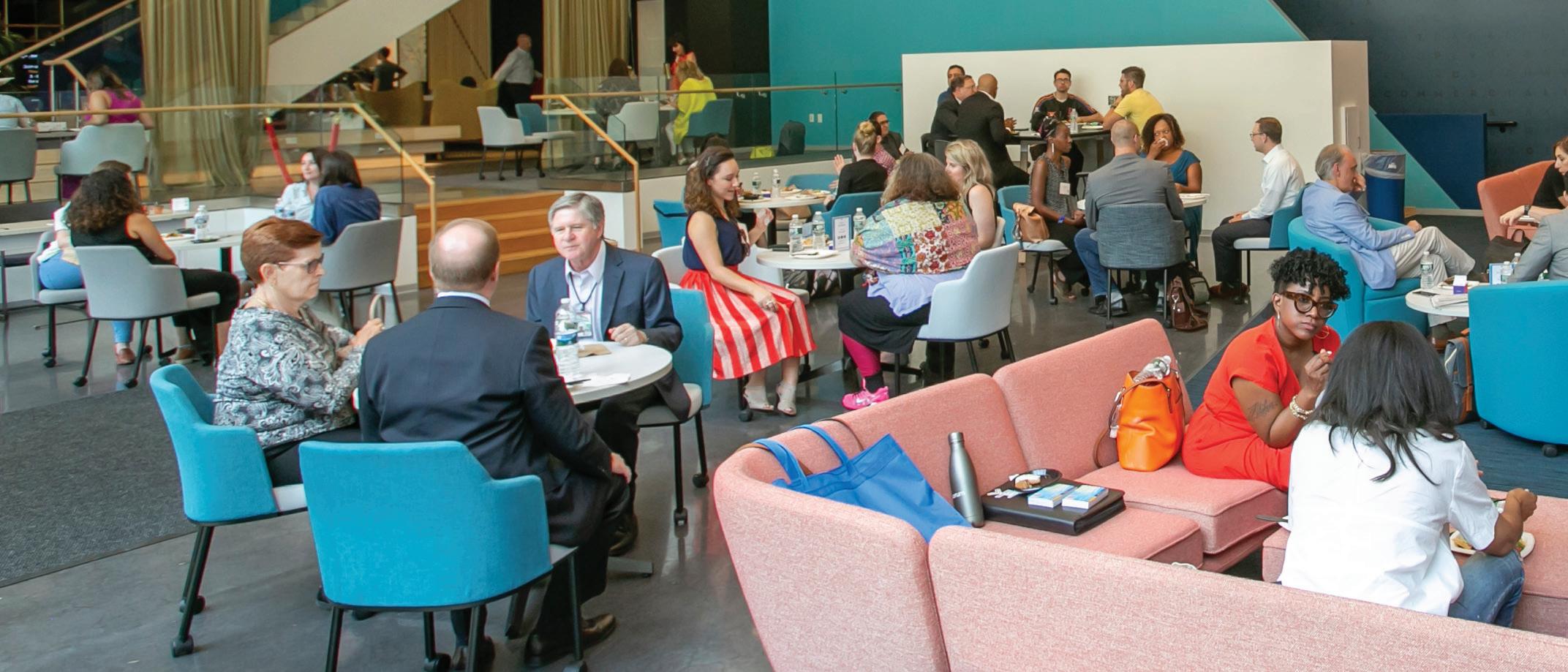
Filling Startup Ecosystem Gaps Since 1963 23
Impacts of uCity Square
RESILIENCY OF INNOVATION ACTIVITY
The growth and success of uCity Square has been particularly notable amidst the economic climate of upheaval from the COVID-19 pandemic and the subsequent reduction of in-office activity across many commercial hubs. Activity continued across uCity Square throughout the course of the pandemic, enabled in part by the Science Center’s efforts to safely maintain lab space. With ample space between work areas and sanitary measures in place, such as hand sanitizer access and self-cleaning elevator buttons, tenants were able to safely continue in-person work.
As the economy emerges from the pandemic, and the market for traditional office space struggles to rebound due to the durability of remote work, the nature of life sciences activity creates a continued demand for lab and collaborative space. uCity Square’s ability to maintain a vibrant physical environment is crucial for its continued success. The demand for leased spaces within uCity Square signifies the value that organizations and individuals place on face-to-face interactions, collaboration, and the unique offerings provided at uCity Square.
By fostering in-person activity, the Science Center helps to keep the local economy running. The presence of diverse stakeholders, such as entrepreneurs, researchers, investors, and visitors, contributes to the local economy through direct and indirect spending. This includes patronizing local businesses, restaurants, shops, and services, leading to a range of spillover effects that extend beyond the campus itself.
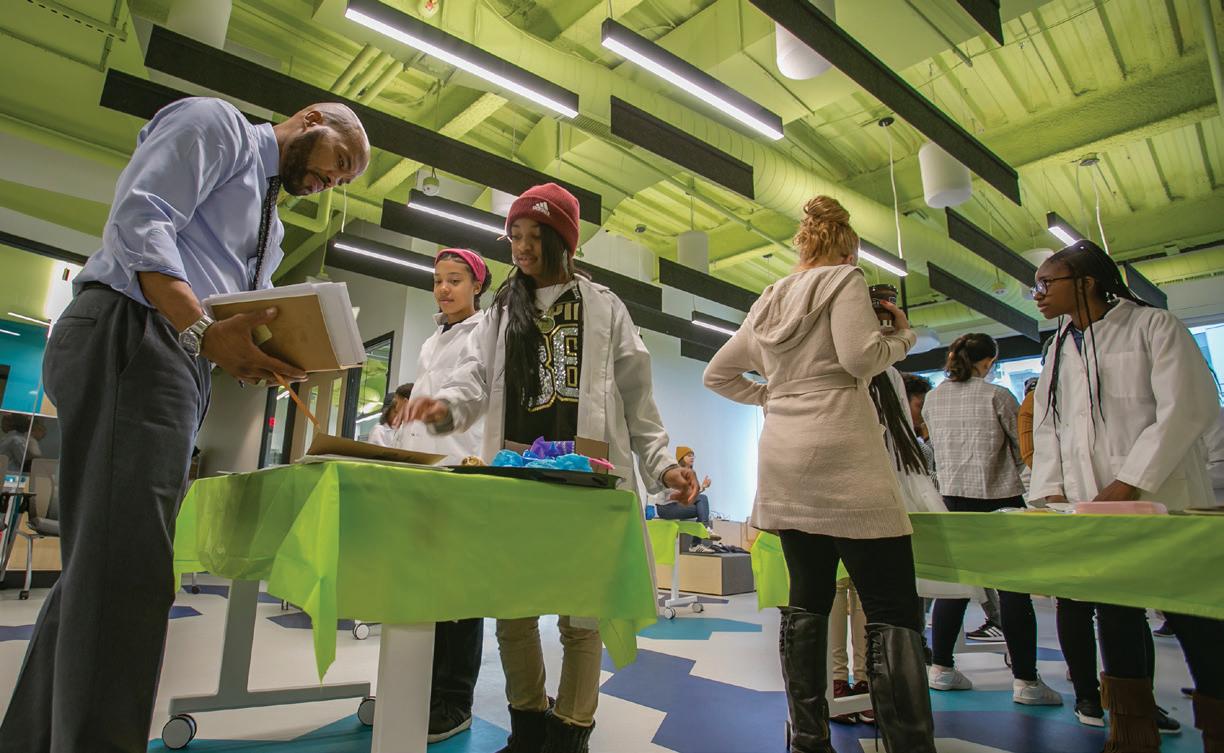
PROVIDING SPACES TO FOSTER COMMUNITY
The Science Center helps to curate a thriving innovation community at uCity Square through the intentional selection of companies that occupy these spaces. By choosing companies that can foster knowledge sharing and collaboration, the Science Center cultivates an innovative ecosystem that surpasses the sum of its parts. This approach benefits not only the companies themselves but also the broader community in Philadelphia, as innovation is a key driver of the city’s economic growth.
In addition to its positive impact on economic growth, the Science Center’s influence on the community also extends to social benefits. As highlighted in the previous section, the Science Center operates a diverse range of public spaces that offer engaging and educational programming for the local community. The Quorum facility, for example, provides event space for missionaligned organizations to utilize. Additionally, Venture Café provides programming and networking opportunities for entrepreneurs, investors, and Philadelphia community members alike. These events foster collaboration and help to build relationships between individuals and organizations that might not have otherwise connected.
Art is critical to community-building. From 1976 through 2022, the Science Center’s Esther Klein Gallery offered a unique opportunity for the community to engage with science through art. For over 45 years, the gallery showcased art installations that explored the intersection of science, technology, and art, providing a unique perspective on the latest scientific advancements. Art at the Science Center will continue with exhibitions throughout 3675 Market Street. The public art pieces around uCity Square also add to the community’s vibrancy and make it a more attractive place to live, work, and visit.
Through these communal and artistic spaces, as well as its varied programming, the Science Center contributes to a thriving ecosystem for innovation in University City and fosters greater engagement between the research community and Greater Philadelphia.
University City Science Center 24

Filling Startup Ecosystem Gaps Since 1963 25 Impacts of uCity Square
The Science Center in the Regional Innovation Ecosystem
Economic research has illustrated the importance of industry clusters, where knowledge is shared and advanced between collaborative and competitive institutions working on similar issues. Innovation Districts have been one such model of growth, and the talent, infrastructure and investment that drive the life sciences cluster in University City represents one of the prime competitive growth opportunities for the region and Commonwealth of Pennsylvania.
Successful clusters do not arise purely by coincidence. In addition to cutting edge research, a collaborative ecosystem is needed to ensure that a district flourishes, and that its success translates into broadly shared benefits for the surrounding community and region. The Science Center is a convener of and partner to many of the leading institutions in the regional innovation ecosystem, acting as a driver of technology transfer and commercialization that helps turn ideas into companies. The Science Center also acts as a steward of the workforce development and STEM education efforts that help supply firms with the talent pipeline they need; this in turn helps to ensure that the benefit of new economic activity reaches the local community.
This section details the many ways in which the Science Center helps to enhance the contribution of the University City innovation cluster to the success of the broader region.
Life sciences is a significant innovation focus across Pennsylvania, with the strongest concentration in the Philadelphia area. The Philadelphia metro has become a global leader in cell and gene therapy in recent years.
Brookings Metro Commonwealth of Innovation Report

University City Science Center 26
The Economic Importance of the Philadelphia Life Sciences Industry
The Philadelphia region and the state of Pennsylvania have been “slow growth” areas in recent decades, as demographic and economic trends have shifted the national focus of growth away from the traditional Northeast and Midwest manufacturing hubs. While many former manufacturing centers have struggled to retool their economies, the Philadelphia region retains significant infrastructure and assets in research, education and healthcare that have helped the city to begin to increase its population and jobs in the first two decades of the 21st century, after decades of decline.
As the region’s profile and talent base in life sciences continues to grow, this ecosystem represents one of the key potential drivers of innovation and growth for the Commonwealth of Pennsylvania.
A 2022 report from Brookings Metro analyzed trends in innovation activity across the state and identified life sciences as the highest priority cluster for Pennsylvania’s innovation agenda.5 The study noted that the strength of these clusters is characterized by “significant business sector
research strengths … dovetailing with the state’s notable academic strengths to propel emerging advanced industry concentrations;” and reported that 60% of the state’s employers in the life sciences industries were located in the Southeast region.
National research has also confirmed Philadelphia’s emergence and competitive strength in the life sciences sector. Philadelphia ranked 6th amongst U.S. markets in CBRE’s 2023 Life Sciences Research Talent Report.6 The region has nearly 20,000 researchers directly employed in the life sciences as of 2022, an 18% increase since 2017.
Beyond the scale of direct employment, this activity has the potential to be a durable and crucial economic driver for the region and the Commonwealth for several reasons. Research activities in the region draw funding from government, academic, and private sources, thereby fostering a dynamic modern export industry. This funding supports high wage employment, which in turn drives local demand for household goods and services throughout the region’s
5 “Commonwealth of Innovation: A Policy Agenda for Revitalizing Pennsylvania’s Economic Dynamism”, 2022, https://www.brookings.edu/wp-content/uploads/2022/10/PAInnovationReport_FullReport.pdf
6 CBRE Research, “Evolving Workforces U.S. Life Sciences Research Talent 2023,” https://mediaassets.cbre.com/-/media/project/cbre/shared-site/insights/ books/2023-book-media-folder/us-life-sciences-research-talent-2023-media-folder/life-sciences-talent-2023.pdf?rev=d954c9ab039343f1a02773237a7827a8
The Science Center in the Regional Innovation Ecosystem
Filling Startup Ecosystem Gaps Since 1963 27
economy. The demand for life sciences activity continues to grow, with consistent advances in technology and health. Activity related to the life sciences sector is difficult to perform remotely, thus increasing the localized impact.
The Growth of the University City Innovation District
For more than two decades, urban economics has underscored the importance of clusters: geographic areas where innovative companies locate near one another, enabling collaboration, and creating a community of highly skilled workers that is attractive to relocating firms. This in turn enables the creation of new startups.7
Today, urban innovation districts represent some of the most important clusters in metropolitan regions.8 These communities combine concentrations of innovation-oriented firms, often anchored by major universities, with a walkable, amenity-rich environment that is attractive to young, highly skilled workers. Urban innovation districts often drive regional growth, attracting a new generation of highly skilled workers. In a post-pandemic era when many of the business services employers that have traditionally defined urban central business districts are permanently turning to hybrid or remote work arrangements, fundamentally altering the economies of downtown districts like Center City Philadelphia, the in-person nature of university instruction and scientific research means that innovation districts will play an even more critical role in defining urban economies.
Philadelphia’s primary urban innovation district is University City, the West Philadelphia neighborhood that hosts Drexel University, the University of Pennsylvania, the Children’s Hospital of Philadelphia, St. Joseph’s University (formerly University of the Sciences), The Wistar Institute, and numerous other major research and academic institutions, including a growing cell and gene therapy cluster.9 The Science Center played a critical role in the shaping of the University City innovation district, and it continues to be a driving force in the district’s success, by incubating successful startups, convening its constituents, and serving as an anchor institution in Philadelphia’s innovation economy.
When the Science Center was established in 1963 as part of a collaboration between several of the region’s major institutions, led by the University of Pennsylvania, it was the first research park ever located in an urban environment.10 This bet on the potential for an urban innovation hub paid off over decades of gradual investments and successes, including the establishment of a business incubator in 2000. It has culminated in a dramatic reshaping of the University City corridor, with major real estate developments abundant, including uCity Square, with millions of square feet of life sciences space completed and millions more on the docket.11 2021 saw a record-setting number of job postings at University City anchor employers.12 The towers and construction cranes that dot West Market Street are perhaps the most visible example of the success of the efforts to develop University City into a world-class innovation district.
7 Michael Porter, “Clusters and the New Economics of Competition,” Harvard Business Review, 1998, https://hbr.org/1998/11/clusters-and-the-new-economics-of-competition
8 Bruce Katz and Julie Wagner, “The Rise of Innovation Districts: A New Geography of Innovation in America”, https://www.brookings.edu/essay/rise-of-innovation-districts/
9 Paige Gross, “Why Philly ranks #2 among best cell and gene therapy hubs in the US”, Technical.ly, 2022, https://technical.ly/civic-news/philly-ranked-2nd-cellgene-therapy-hubs/
10 John L. Puckett, “University City Science Center,” Philadelphia Encyclopedia, https://philadelphiaencyclopedia.org/essays/university-city-science-center/ 11 “uCity Square”, Wexford Science + Technology, https://wexfordscitech.com/community/ucity-square/ 12 “The State of University City 2022 Report from the University City District”, 2022, https://almanac.upenn.edu/articles/the-state-of-university-city-2022-reportfrom-the-university-city-district
University City Science Center 28
Enhancing Regional Technology Transfer Capability
Technology transfer (defined as “the process by which new inventions and other innovations created in [research] institutions’ labs are turned into products and commercialized”13) sits at the intersection of academic research and private industry. By commercializing academic research, universities contribute to the creation of new industries, the development of advanced technologies, and the improvement of existing products and services. The successful transfer of technology from universities to the private sector spurs economic growth, enhances national competitiveness, and propels the country forward in the global innovation race.
For decades, the Science Center has played a critical role in enabling technology transfer from academic and research institutions across Pennsylvania, New Jersey, and Delaware. The technology transfer initiatives led by the Science Center included the QED Proof-of-Concept Program, an initiative that provided funding and business development support for academic researchers developing earlystage life science and healthcare technologies with high commercial potential. This program supported dozens of projects. As of 2016, nearly one-third of all QED projects had been licensed, and five of the projects led to spinoff startups.14 The QED Program ended in 2022 and transitioned to Founders Fellowship, a 12-month experiential program offering hands-on startup experience for individuals with an advanced STEM degree to transform concepts into a business reality.
Those participants receive a $50K annual stipend and access to the Science Center’s network of experts, investors, and entrepreneurs. They also gain access to facilities at CIC Labs + Innovation Campus at uCity Square, which contain state-of-the-art laboratories.
Collaborations for the Greatest Impact to the Life Sciences Sector
The Science Center has worked closely with Ben Franklin Technology Partners, the public-sector, innovation-focused economic development organization founded by the Pennsylvania Department of Community and Economic Development (DCED) four decades ago. Ben Franklin Technology Partners is a resource for capital and business support for startups across the state. The two organizations collaborate to enhance Philadelphia’s innovation ecosystem, notably by bolstering the city’s recognition within the Global Startup Ecosystem Report.15 The symbiotic relationship between the Science Center and Ben Franklin Technology Partners boosts both institutions and supports innovation in Greater Philadelphia and across the Commonwealth.
According to a Brookings Metro report, Pennsylvania must unlock its innovation potential by implementing state-level policies.16 The Science Center exemplifies many of the best practices for regional innovation ecosystems highlighted in the Brookings analysis. As Pennsylvania looks to boost R&D, entrepreneurship, and technology-based economic growth, the Science Center can serve as an effective model for public-private partnerships that catalyze innovation and revitalize regions.
13 “The 2023-24 Directory of Life Sciences VCs”, Tech Transfer Central, https://techtransfercentral.com/what-is-technology-transfer/ 14 “Why Philly Trails Other Cities in Tech Transfer — and How We Can Fix It”, Science Center, 2016, https://sciencecenter.org/news/why-philly-trails-other-cities-intech-transfer-and-how-we-can-fix-it
15 https://sciencecenter.org/news/startup-genome-and-ben-franklin-technology-partners-university-city-science-center-and-drexel-university-publish-2021-global-startup-ecosystem-report
16 “Commonwealth of Innovation: A Policy Agenda for Revitalizing Pennsylvania’s Economic Dynamism”, 2022, https://www.brookings.edu/wp-content/uploads/2022/10/PAInnovationReport_FullReport.pdf
The Science Center in the Regional Innovation Ecosystem
Filling Startup Ecosystem Gaps Since 1963 29
The Science Center as a Catalyst for Inclusive Growth
Jobs at firms supported by the Science Center command an average salary of
The potential for the life sciences sector to improve the region’s quality of life will go unrealized unless it can expand its impact beyond specialized research and create inclusive economic opportunities, considering its vital role in the region’s economic progress. The regional life sciences industry has enormous potential to drive equitable economic growth by fostering innovation, creating, and supporting high-quality and family-sustaining jobs, and addressing health disparities in underserved communities.
$105,000 83% ABOVE $57,500, THE MEDIAN ANNUAL WAGE IN THE REGION
as reported in 2022

University City Science Center 30
THE SCIENCE CENTER HAS EMBRACED ITS ROLE IN HELPING TO TRANSLATE INNOVATION-LED GROWTH TO EQUITABLE OUTCOMES
Job Creation and Training: Life sciences companies require a range of skilled professionals, from researchers and scientists to technicians, engineers, and administrative staff. As these companies expand, they create diverse job opportunities that span education levels and skill sets. By providing training and employment opportunities for people from different backgrounds, life sciences companies help to uplift local communities and promote upward mobility. The Science Center connects growing life sciences companies to job seekers, building new, inclusive career pathways.
Innovation and Research: Life sciences companies engage in research and development that often leads to groundbreaking medical treatments, therapies, and technologies. These innovations directly improve health outcomes for individuals across various demographics. By targeting diseases that disproportionately affect marginalized communities and developing accessible treatments, these companies contribute to reducing health disparities.
Entrepreneurship and Innovation Ecosystems: The Science Center fosters entrepreneurship by investing in startups, providing mentorship, and sharing resources. This support encourages diverse founders to enter the industry and contribute their unique perspectives to solving healthcare challenges.
Diversity, Equity, and Inclusion: Promoting diversity, equity and inclusion within their workforce is vital for life sciences companies. By fostering a diverse employee base through their hiring practices, these companies harness a wide range of perspectives and insights, leading to more comprehensive and effective solutions that address the needs of various communities.
Local Economic Development: As life sciences companies grow, they often require infrastructure such as research facilities, office spaces, and manufacturing sites. This expansion stimulates local economies by attracting additional businesses and creating a demand for local services.
As a leader, connector, and convener, the Science Center is achieving its mission.
Filling Startup Ecosystem Gaps Since 1963 31
Connector Convener Leader The Science Center in the Regional Innovation Ecosystem
This report was produced by Econsult Solutions, Inc. (“ESI”). ESI is a Philadelphiabased economic consulting firm that provides businesses and public policy makers with economic consulting services in urban economics, real estate economics, transportation, public infrastructure, development, public policy and finance, community and neighborhood development, planning, as well as expert witness services for litigation support. Its principals are nationally recognized experts in urban development, real estate, government and public policy, planning, transportation, non-profit management, business strategy and administration, as well as litigation and commercial damages. Staff members have outstanding professional and academic credentials, including active positions at the university level, wide experience at the highest levels of the public policy process and extensive consulting experience.
1435 WALNUT STREET, 4TH FLOOR | PHILADELPHIA, PA 19102 215-717-2777 | ECONSULTSOLUTIONS.COM




















